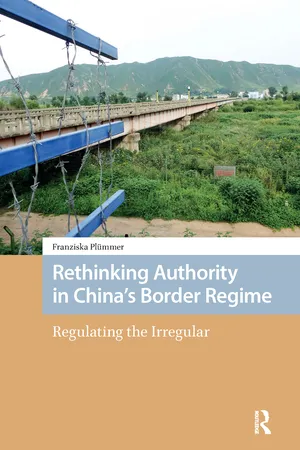
- English
- ePUB (mobile friendly)
- Available on iOS & Android
About this book
In the 21st century, governments around the globe are faced with the question on how to tackle new migratory mobilities. Governments increasingly become aware of irregular immigration and are forced to re-negotiate the dilemma of open but secure borders. Rethinking Authority in China's Border Regime: Regulating the Irregular investigates the Chinese government's response to this phenomenon. Hence, this book presents a comprehensive analysis of the Chinese border regime. It explores the regulatory framework of border mobility in China by analysing laws, institutions, and discourses as part of an ethnographic border regime analysis. It argues that the Chinese state deliberately creates 'zones of exception' along its border. In these zones, local governments function as 'scalar managers' that establish cross-border relations to facilitate cross-border mobility and create local migration systems that build on their own notion of legality by issuing locally valid border documents. The book presents an empirically rich story of how border politics are implemented and theoretically contributes to debates on territoriality and sovereignty as well as to the question of how authority is exerted through border management. Empirically, the analysis builds on two case studies at the Sino-Myanmar and Sino-North Korean borders to illustrate how local practices are embedded in multiscalar mobility regulation including regional organizations such as the Greater Mekong Subregion and the Greater Tumen Initiative.
Frequently asked questions
- Essential is ideal for learners and professionals who enjoy exploring a wide range of subjects. Access the Essential Library with 800,000+ trusted titles and best-sellers across business, personal growth, and the humanities. Includes unlimited reading time and Standard Read Aloud voice.
- Complete: Perfect for advanced learners and researchers needing full, unrestricted access. Unlock 1.4M+ books across hundreds of subjects, including academic and specialized titles. The Complete Plan also includes advanced features like Premium Read Aloud and Research Assistant.
Please note we cannot support devices running on iOS 13 and Android 7 or earlier. Learn more about using the app.
Information
Table of contents
- Cover
- Half Title
- Title Page
- Copyright Page
- Table of Contents
- List of Maps, Tables, and Figures
- List of Abbreviations
- Acknowledgements
- 1 Introduction
- Multiple Borders – Tracking the Border down
- Contextualizing Chinese Border Politics in the Making
- On Border Regimes, Sovereignty, and Immigration
- Methodological Reflections
- Map of the Book
- 2 Border Authority and Zoning Technologies
- Border as a Method of Investigation
- Territorial Governmentality and Zoning Technologies
- Self-regulation and Self-responsibility in China’s Neo-socialist Governmentality
- 3 Graduated Citizenship and Social Control in China’s Immigration System
- The Power to Choose
- Characteristics of the Chinese Immigration System
- Labelling Immigrants: Differentiating Legal Authority and Control over Immigrants
- Rationalities of the Chinese Immigration System
- 4 Making Border Politics: State Actors & Security in the Chinese Border Regime
- Locating Border Security Control: Externalization/Internalization
- State Configurations in Border Politics
- Defending the Border: Security Enforcement
- Internal Border Security: Developing Border Areas from Within
- Policing at Distance and Local Exceptions
- 5 Re-Scaling Territorial Authority within Regional Organizations
- From Left behind to Bridging the Gap: Re-scaling the Chinese State
- Greater Mekong Subregion (GMS)
- Greater Tumen Initiative (GTI)
- Zoning through Development
- 6 Local Bordering Practices and Zoning Technologies
- Southwest: Dehong and Xishuangbanna Prefecture/Yunnan Province
- Northeast: Yanbian Prefecture/Jilin Province
- Legality as a Selective, Conditional, and Locally Bound Privilege
- 7 Conclusion — Authority in the Chinese Border Regime
- Special Border Zones: Normalizing Local Exceptions
- The Role of Local Governments in China’s Border Management
- Border as a Method of Social Control: Graduated Citizenship in China’s Immigration System
- Border as a Method of Spatial Development: Territoriality and Centre-Periphery Relations
- References
- Appendix A: Institutional Architecture of Yunnan Province in the GMS
- Appendix B: Institutional Architecture of Jilin Province in the GTI
- Glossary
- Index